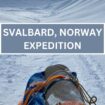
Fancy an Amundsen-esque experience trekking across the frozen Arctic pulling a pulka sled and camping out under the flirtatious flicker of the Northern Lights?
If so, strap on your snowshoes, clip on your pulka sled and embark on an ‘Arctic-Lite’ expedition to Svalbard, Norway. It’ll be like nothing you have ever done before.
“You will hear the bear coming before you see it. If you do, blow the air horn and we will come with our rifles to scare it off.” Erland informed us of this as we sat around the paraffin stove in the communal tent thawing the ice cubes masquerading as our toes.
By that point it was -25c outside, with the wind wickedly whipping the temperature yet lower. The warmth of the stove was as welcome as Erland’s comment was unnerving.
Whilst bear sightings are relatively rare in Svalbard, as they tend to live over on the uninhabited east coast, this was no tourist gimmick. The threat was as real and ethereal as the bears themselves.
It was only 18 months earlier that a camper had been killed because there was no overnight watch to raise the alarm at the bear’s desperate nocturnal foraging foray.
Imbued with a suitable sense of deference, yet still, with a generous sprinkling of excitement, we set about divvying up the rota for the night shift.
But all that was to come later.
Where and What is Svalbard?
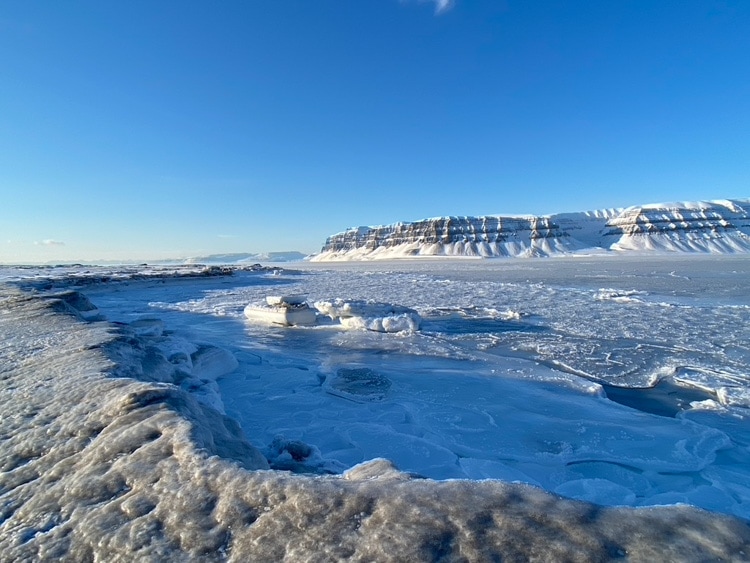
Svalbard is a group of Norwegian islands located comfortably within the icy longitudinal embrace of the Arctic Circle. Its place in Arctic folklore is as solidified as its permafrost, counting Roald Amundsen amongst the most auspicious of its expeditionary alumni.
It continues to offer valuable research insight into the Arctic desert ecosystem. Over 65% of the archipelago is protected as national parks or nature reserves. Furthermore, it serves as a jumping-off point for expeditions to the North Pole.
It also has two things that its Antarctic cousin doesn’t. First is cost-effective elementalism. It provides the ability to pit your wits against the extreme sub-zero temperatures of the Arctic desert, but for a fraction of the cost of a corresponding Antarctic adventure. Second is mammalian, in the form of Svalbard’s most famous resident, the polar bear.
Both factors combined to see me visiting just as the blanket of the “dark season” was flung aside, ushering in the start of the “light season”.
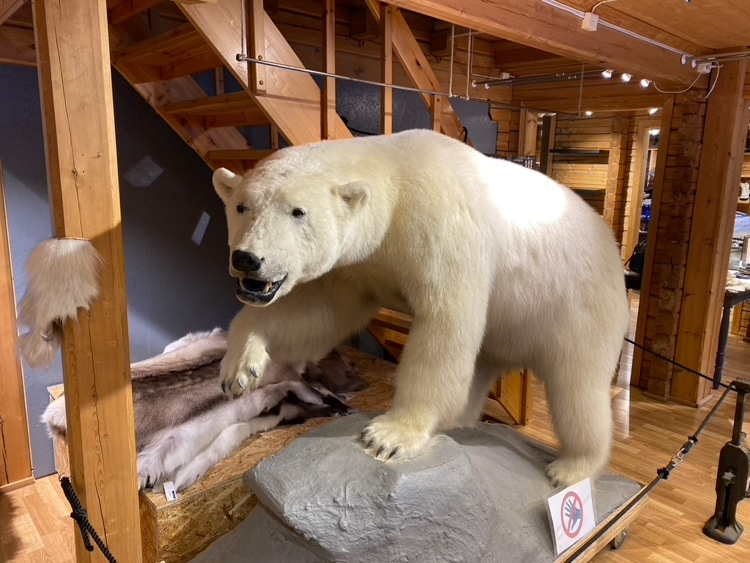
Bears of Longyearbyen
You can hardly walk 50 yards through Longyearbyen, Svalbard’s main town, without passing the omnipresent watchful gaze of a bear (albeit in inanimate form). You are greeted at the airport by a taxidermically pensive bear stalking your luggage as it emerges on the baggage reclaim belt.
It is also on the logo of the supermarket. Plus, it can be found on a multiplicity of souvenirs from fridge magnets to shot glasses, from cuddly toys to over-priced (but exceptionally warm) neck buffs.
Given the polar pomp and circumstance, I hoped that the omens for a sighting were good.
Acclimatation Day
The trip that I had booked involved one ‘acclimatation day.’ This was to be a 7.5 km round trip hike to an ice cave on the Nybyen glacier to test our kit. Then we were to head out for 3 days of trekking across the Arctic desert pulling a pulka sled, with 2 overnight wild camps.
The final day involved bombing it across the tundra on a snowmobile (oddly, called scooters up there) to visit the face of the mighty Tempelfjorden glacier.
Pre-trip, we were supplied with a significant packing list. The key to this was layers. When you are out and about, if you don’t have the right kit, you will be quickly found out. It can make the difference between a life-affirming and a life-endangering experience).
The acclimatation day was helpful. Pre-trip, I had assumed that I would be trekking in my large down jacket due to the temperatures (that bottomed out at around -30oc, pre-wind chill, during our trip). That quickly proved to be incorrect.
It turns out that wearing a heavy down jacket turns you into something akin to a boil-in-the-bag meal, one of your food staples over the coming days.
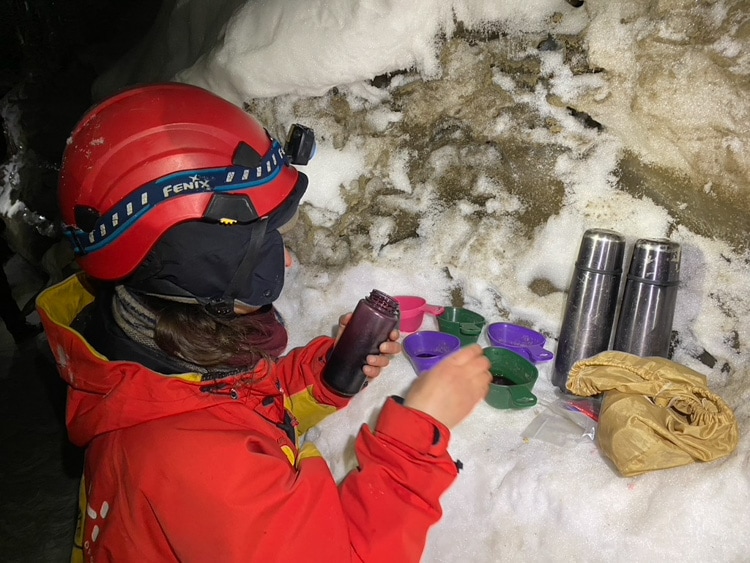
Tea Time in an Ice Cave
The ice cave that we visited was beautiful, once we managed to get into it. On arrival, we were greeted by two solitary red poles sticking out of the ground surrounded by a 150cm snowdrift.
This was quickly excavated with considerable dexterity and aplomb by our guide, Isi (with the assistance of her pet husky, Jersey), exposing the entrance to the subterranean wonders that awaited us.
As we descended into the cave, we were greeted with swirling seams of ice that looked like the rings of Saturn rippling above our heads. These were interspersed with the delicate beauty of ice stalactites hanging like glacial chandeliers from the ceiling.
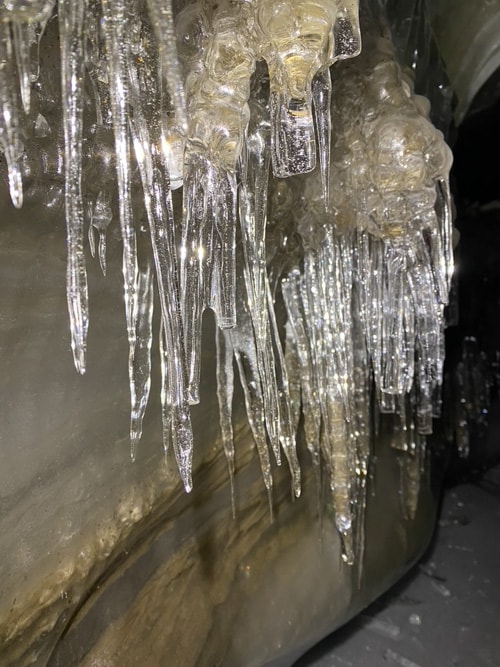
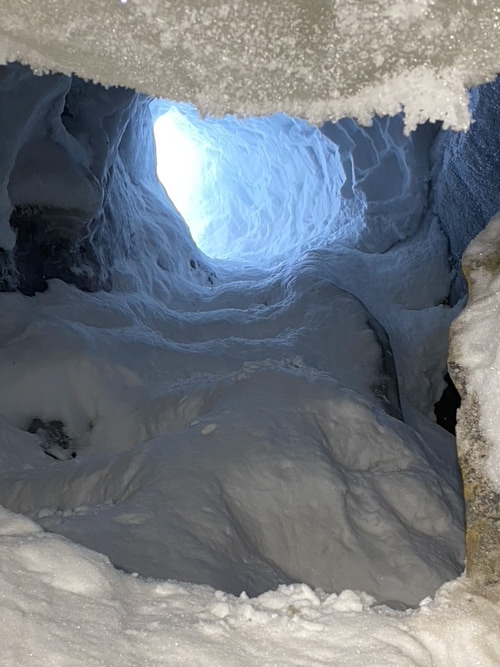
The ice itself was crystal clear. You could make out air bubbles and lines of mud, silt and rock deposited in the glacial flow from time immemorial. The surface of the ice is completely dry to the touch. This allowed us to run our fingers across (or try licking) it without any fear of sticking.
We stopped for a tea (or in our case, hot toddy) break with biscuits in the ice cave. Having gazed upon its wonderous secrets, we had the opportunity to reflect on the fact that this was a taster of things to come.
Svalbard Expedition: Day One
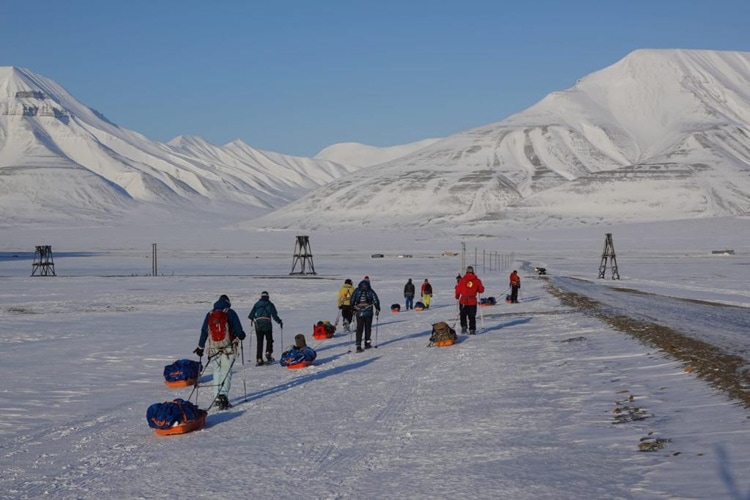
The ‘main trip’ began the following morning. Packing up our pulka sleds at HQ, we were supplied with even more kit, including food and sleeping gear. Thankfully, we quickly learned that you don’t feel the weight in the sled when you are pulling it.
With pulkas packed (20 – 30 kg each), we set off from Longyearbyen for our first day of hiking. It was just under a 6 km uphill hike to our overnight camp, in an ice cave. It’s hard not to feel like Arctic explorers of yesteryear, such as Amundsen, when you don your snowshoes, clip on your pulka sled and head out into the great unspoilt frozen landscape unfolding before you.
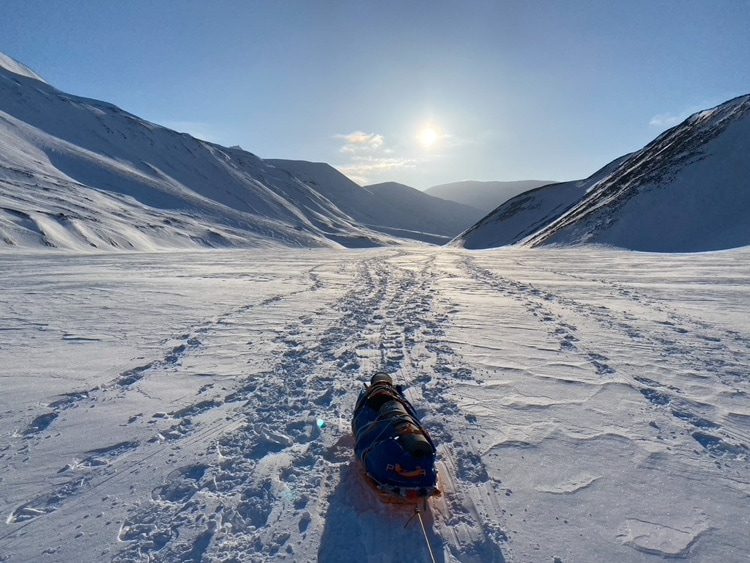
Amusingly, on the way up the first hill to our camp a small procession of snowmobiles tried to pass us. But they found that they didn’t have enough of a head of steam to get up the hill. It was deeply satisfying to trudge purposefully past them whilst they sat helplessly on their mechanical steeds, before having to turn back and try again.
Arriving at the ice cave around early evening, the first order of business, after a quick tour of the cave, was to tackle the logistical headache of getting all necessary kit below ground. Navigating an ice cave is hard enough when you are just having a look around.
It was formed by a winding narrow path, often going through small crawlspaces and under awkward overhangs that needed to be navigated with gymnast-esque contortion. A couple of trips to and from the surface were required to ferry the necessary overnight paraphernalia to your chosen sleeping spot.
Sleeping in an Ice Cave
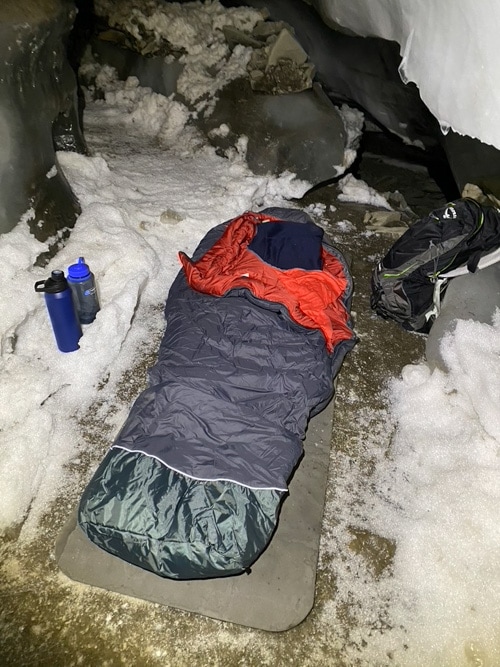
Choosing a sleeping spot was far from straightforward. When we were told that we would be sleeping in an ice cave, this conjured up images of sleeping as a group in a large ice-clad cavern. Not so.
Each member of the group was required to pick a spot (often on or under a narrow ice ledge), alongside the winding path of the cave, upon which to stake your nocturnal claim.
Having addressed the necessary ice cave nocturnal admin, we headed back to the surface for dinner. By this time, Erland and Nicklas had already dug out a campfire and seating area by the entrance to the cave. The fire was soon roaring away.
Dinner, a boil-in-the-bag meal, was welcome, warm sustenance. By this time it was around -25oc above ground and the wind was picking up.
But the cold was soon banished from our minds as we were treated to a short display of the Northern Lights flirtatiously flickering their green celestial glow over the adjacent mountainside. A magical moment on which to end our evening above ground, before heading below ground to warm up.
Unsurprisingly, when you are in a natural ice cave, it’s pitch black 24/7. So illuminated only by our head torches, we set about climbing into our sleeping bags on our chosen icy nook, in the comparatively balmy -6oc of the ice cave, to settle down for the night.
Quiet would also have descended on that magical place, but for the snoring of a member of the group. The sound reverberated around the cave like a prodigious steam locomotive for most of the night.
Svalbard Expedition: Day Two
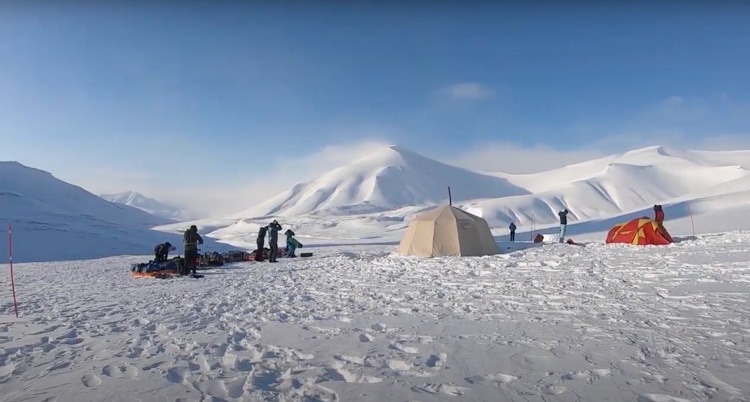
Breakfast in bed was the first order of business the following morning – sadly eggs benedict were off the menu. We had to make do with a muesli/porridge concoction using the lukewarm water from our thermos flasks. Not the most auspicious of breakfasts perhaps; but enjoyed by torchlight in the most auspicious and surreal of surroundings.
Back above ground, we were bathed in resplendent sunshine. We packed our pulkas up and made for the pass about 1km above us. When we reached the top, we were greeted with a nice 1 km downhill stretch and repurposed our pulkas into toboggans.
I challenge anyone not to grin from ear to ear whilst sliding down a hill on your pulka. Even with the inevitably unceremonious dismount at the end.
Our camp for the final evening was a short hike away. This time, we would be camping under canvas. We slept in a large communal Lavvo tent (used by the Saami) complete with a paraffin stove in the middle. That, combined with a ‘sit down loo’ (i.e. a box with bio bags), made for quite the luxurious experience compared with the previous evening.
We had an afternoon hike, minus the pulkas. Then we settled in for the evening, watching the dying sunlight paint the adjacent mountains in a celestial rosy hue, before preparing for what lay ahead…polar bear watch.
Polar Bear Precautions
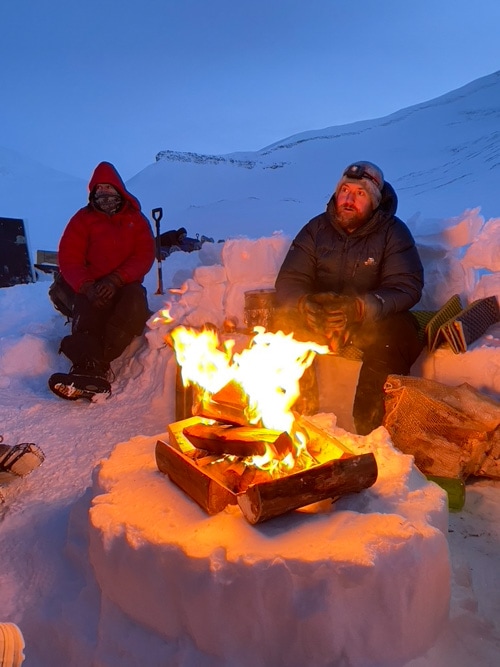
It is illegal to leave Longyearbyen without taking suitable polar bear precautions. Whilst sightings of, and encounters with, bears are relatively rare our guides carried flare guns and rifles to use as a last resort.
As non-guides, our weapon while on watch was a loud air horn to raise the alarm if a bear was sighted or heard. It’s generally their lumbering trudge that alerts you first, rather than a sighting of their headtorch-illuminated eyes).
Polar bear watch constituted a 2-hour shift each. The first hour was spent awake in the tent keeping an eye on the fire. The second hour was spent outside on the lookout for bears. My shift was from 02:00 – 04:00. I hardly slept beforehand due to the excitement of what lay ahead (although the cold probably played a part too).
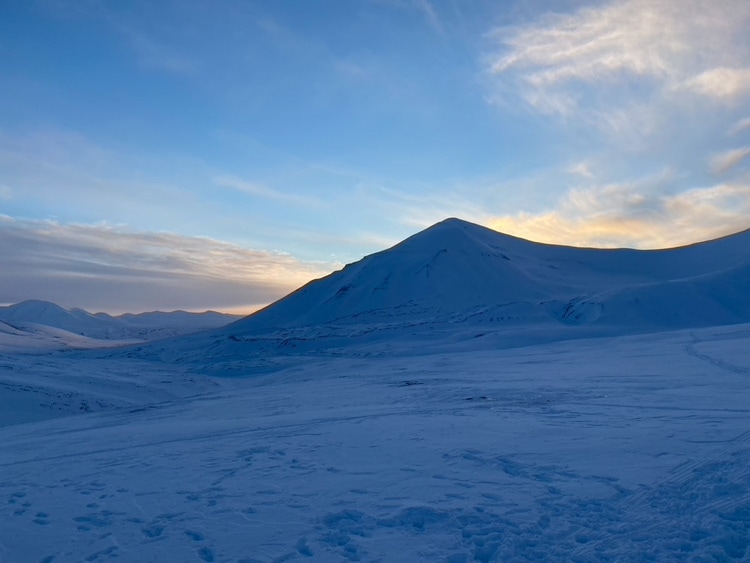
By the time I made it outside, it was around -30oc, which caused my eyelids to start to stick together. But the first light of dawn was just beginning to appear over the mountains as I unzipped the door of the tent.
It was a truly humbling experience soaking up the serene, rugged majesty of Svalbard by night, with the crunching of my boots in the snow and the whistling of the Arctic wind past my ear as the only sounds.
Sadly, no one in the group sighted a bear. We settled instead for our polar bear fridge magnets, but that didn’t detract from an unforgettable experience.
Svalbard Expedition: Day Three
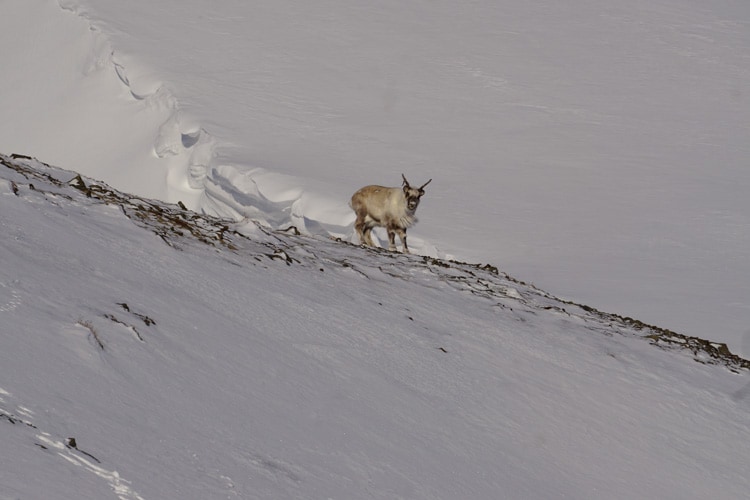
Our final morning of the hike saw us break down camp and trudge the final 9 km back towards civilisation. On the way, we encountered various small groups of inquisitive reindeer who flanked our descent from a cautiously curious distance.
Around 1.5 km from the finish, we encountered a truly curious sight – a post box affixed to a wooden post to the side of the path running along the valley floor. There are a number of these post boxes dotted around the Svalbard landscape. Each box contains a guest book – the idea is that it encourages people to get out and about and explore.
We dutifully signed our names and headed for home, with an obligatory stop at a restaurant for a well-earned hearty meal and drinks.
On the final morning, we traded our plastic pulkas for mechanical steeds, in the form of snowmobiles, to whizz across the frozen tundra from Longyearbyen to the Tempelfjorden glacier. A very different, high-octane experience to the slow methodical progress of the previous days, but no less exhilarating.
We soaked in the landscape as it whizzed past us, all the while fighting the biting wind in its tireless quest to find a chink in our multiple insulating layers.
Reflections and Souvenirs
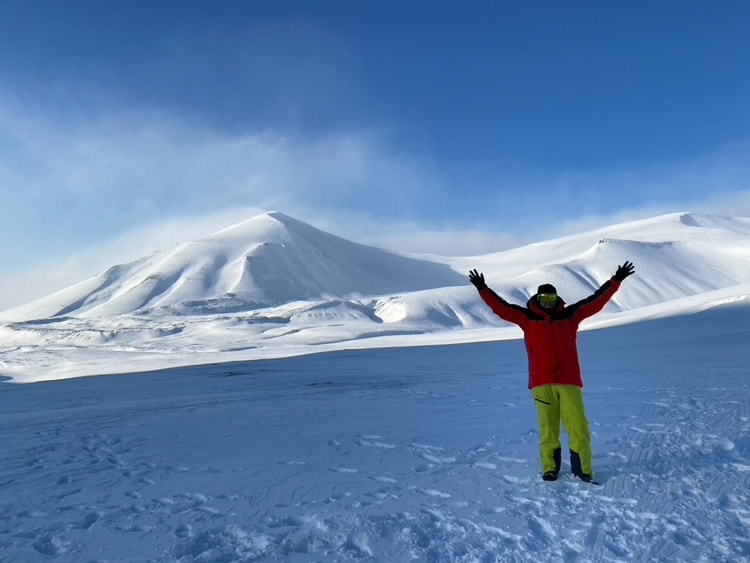
As we stood on the promontory overlooking the Tempelfjorden glacier, enjoying our final boil-in-the-bag meal, it gave the perfect opportunity to reflect on the trip. It truly was an experience of a lifetime exploring a tiny portion of the rugged and desolately beautiful, almost lunar, landscape of Svalbard.
We all left with souvenirs that we will cherish forever (in the form of memories and an obligatory polar bear fridge magnet.) Plus ones that we hope will soon fade away (in the form of frostbitten toes).
To learn more, see Svalbard Island, Norway
Tom travelled to Svalbard in March 2022 with Much Better Adventures and their local partner, Svalbard Wildlife Expeditions.
Inspire your next adventure with our articles below:
Author Bio: “Tom is a freelance travel journalist based on Jersey in the Channel Islands. His passion is getting off the beaten track to explore places that are misunderstood or not on the average traveller’s radar. He loves immersing himself in the local culture and chatting with locals, so that he can provide readers with an informed narrative about the local quirks of everyday life.”
Want to discover more hidden gems and helpful travel tips? Join our free newsletter for the latest travel secrets and travel articles.
We are reader-supported and may earn a commission on purchases made through links in this article.

